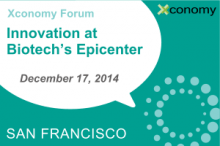 Last week we had the pleasure of speaking at the Xconomy Forum: Innovation at Biotech’s Epicenter. It was only fitting that this meeting be hosted in the burgeoning biotech neighborhood of San Francisco’s Mission Bay, the latest urban biotech core to spring up in the Bay Area, the birthplace of modern biotechnology.
Last week we had the pleasure of speaking at the Xconomy Forum: Innovation at Biotech’s Epicenter. It was only fitting that this meeting be hosted in the burgeoning biotech neighborhood of San Francisco’s Mission Bay, the latest urban biotech core to spring up in the Bay Area, the birthplace of modern biotechnology.
The opening Keynote was presented by UCSF’s Chancellor, Sam Hawgood, who argued that the collision between technological sciences and the advancement in big data and medicine has positioned healthcare for a new era in punctuated equilibrium. Hawgood argued that in order to take advantage of this exciting era, the life science and healthcare community must capitalize on partnerships, both public and private, openly sharing data and collaborating on projects. We were humbled that DNAnexus was mentioned by the Chancellor for our contribution to clinical cancer care with UCSF. As we look to 2015, we are prepared for this disruptive change, with collaborative and scalable technologies that enable researchers to work together, share ideas and data, and tackle some of the most exciting opportunities in human health.
Our CMO, Dr. David Shaywitz, played moderator and panelist for the forum’s discussion on big data for big (and small) biopharma, stacked with a very talented and seasoned group of industry leaders: Gini Deshpande, CEO for NuMedii, Dongliang Ge, Director of Bioinformatics for Gilead Sciences, and Rick Morrison, CEO for Comprehend Systems. This group took on challenging questions, like “What is the key blocker to getting pharma to adopt an agile Silicon Valley mindset?” Deshpande noted that applying genomics to drug discovery seemed a bit aspirational to some skeptics at the moment. Morrison argued that it’s hard to break old habits: The Silicon Valley philosophy of “move fast and break things” doesn’t work in medicine — it’s people’s lives at stake if “things break,” he noted.
As expected, there was considerable enthusiasm expressed for leveraging large data sets and smart algorithms to generate verifiable novel insights and new therapies. A thoughtful audience member asked whether the field has gotten out over its skis, and wondered whether drug development has truly been impacted by big data. Shaywitz cited the example of PCSK9-based therapies as one example of where big data – and specifically “happy genomics”, which he has written extensively about here and here – may lead. Right now there are lipid-lowering drugs in late-stage development by Amgen and Regeneron/Sanofi, which came about through genomic studies of the gene PCSK9.
Ge, of Gilead Sciences, also offered another example: Dr. Lukas Wartman, a cancer researcher at Washington University in Saint Louis fell ill to the very disease he was studying. When standard chemotherapy treatments failed him, Wartman and colleagues sequenced his genome, and discovered a gene called FLT3 was being expressed at a much higher level than in healthy individuals. Using a drug-gene interaction database, they found a drug, Sutenet, normally used to in kidney cancer that targets a “hyperactive” FLT3 gene.
The story of Dr. Lukas Wartman really speaks to us at DNAnexus. Eventually we envision a world where it’s routine to sequence the tumor and genome of every patient and produce a clinical report indicating what drugs best target the cancer. Or better yet, a routine non-invasive blood test will catch cancer in its earliest stages, and clinicians will prescribe effective, individualized therapies right away to knock the cancer out. But for now, we are deeply engaged in the discussion around genomics in the clinic and providing the technological backbone that enables various research partnerships through sharing and management of data and tools around large volumes of sequencing data to discover novel insights. By making it easier, and in many cases feasible, to work with genomic data, pharmaceutical companies and their collaborators (both medical centers and, critically, the patients themselves) can benefit from the power of genomics and use this knowledge to drive drug discovery and deliver new medicines to benefit patients.

.png)
.png)
.png)